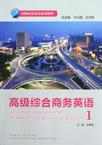高级综合商务英语-1
出版时间:2012-10 出版社:外语教学与研究出版社 作者:彭青龙 主编,凤羽 等编 页数:287
内容概要
彭青龙等编著的《高级综合商务英语》共有12个单元,内容包括经济、管理、法律和文化四大模块,涉及全球经济、国际市场、新兴行业、信息技术、商业创新、法律诉讼、营销策略、危机公关、网络文化、职业规划、金融危机、企业管理等多个主题。每单元均由Lead.in、Text
A、Text B及相关练习组成。Lead—in主题明确、内容新颖、形式多样,具有很强的针对性和启发性。Text
A侧重商务知识习得、语言综合能力和逻辑思辨能力的训练,练习形式主要有篇章理解、完形填空、句子改写、翻译、听力、写作等。Text
B是商务案例语篇阅读材料,注重培养学生分析问题和解决问题的能力,练习包括口述、会谈、辩论、应用文写作等多种形式。各个单元都十分强调口语、写作和商务实践能力,因此相应的配套练习也比较多。
书籍目录
Unit 1 Globalization
Text A The Empire Strikes Back
Text B Disney Theme Park
Unit 2 Film Industry
Text A The Harry Potter Economy
Text B China's Investment in Silver Screen
Unit 3 Property Boom
Text A Between a Rock and a Living Space
Text B Building Excitement
Unit 4 Information Technology
Text A Silicon Valley Visionary Who Put Apple on Top
Text B Nokia at the Crossroads: Blazing Platforms
Unit 5 Creativity and Innovation
Text A The Postmodern Craving for Creativity
Text B Design Thinking
Unit 6 Commercial Litigation
TextA Reducing the Risk of Commercial Litigation in the
United States
Text B The McDonald's Coffee Lawsuit and Now, the Rest of the
Story
Unit 7 Mass Customization
Text A BMW Drives Germany
Text B How Mass Customization Is Changing Our World
Unit 8 Crisis Management
Text A A Crisis Made in Japan
Text B Crisis Management in Belgium: the Case of
Coca-Cola
Unit 9 Internet and Our Life
Text A How Long Will Google's Magic Last?
Text B Has the Internet Brought Us Together or Pulled Us
Apart?
Unit 30 Career Planning
Text A How to Change the World
Text B How Will You Measure Your life?
Unit 13 Financial Crisis
Text A Cinderella's Moment
Text B Fixing Europe's Single Currency
Unit 32 Entrepreneuhip
Text A Can Red Wine Help You Live Forever?
Text B An Interview with Tim Ferriss--Author of The 4-Hour
Workweek
章节摘录
“You get very different thinking if you sit in Shanghai or Sao Pauloor Dubai than if you sit in New York,”says Michael Cannon-Brookes, just off the plane from Bangalorel to Shanghai.“When you want to create a climate and culture of hyper-growth, you really need to live and breathe emerging markets.” Mr. Cannon-Brookes is the head of strategy in IBM's newly created “growth markets” organization, which brings together all of Big Blue,s3operations outside North America and Western Europe. “This is the first line business in 97 years of our history to be run outside the U.S.,” he says excitedly, noting that “Latin America now reports to Shanghai.”IBM's thinking about emerging markets, and indeed about what it means to be a truly global company, has changed radically in the past few years. In 2006 Sam Palmisano, the company's chiefexecutive, gave a speech at INSEAD, a business school in France,describing his vision for the “globally integrated enterprise”.The modern multinational company, he said, had passed through three phases. First came the 19th-century “international model”,with firms based in their home country and selling good sthrough overseas sales offices. This was followed by the classicmultinational firm in which the parent company created smallerversions of itself in countries around the world. IBM worked likethat when he joined it in 1973. The IBM he is now building aimsto replace that model with a single integrated global entity inwhich the firm will move people and jobs anywhere in the world,“based on the right cost, the right skills and the right business environment. And it integrates those operations horizontally and globally.” This way, “work flows to the places where it will be done best.” The forces behind this had become irresistible, said Mr.Palmisano.This ambitious strategy was a response to fierce competition from the emerging markets. In the end, selling the personal-computer business to Lenovo was relatively painless: The business had become commoditized4. But the assault on its services businessled by a trio of Indian outsourcings upstarts6, Tata Consultancy Services, Infosys and Wipro, threatened to do serious damage to what Mr. Palmisano expected to be one of his main sources of growth. So in 2004 IBM bought Daksh, an Indian firm that was a smaller version of the big three, and has built it into a largebusiness able to compete on cost and quality with its Indian rivals.Indeed, IBM believes that all in all it now has a significant edgeover its Indian competitors.Being willing to match India's low-cost model was essential, but Mr. Cannon-Brookes insists that IBM's enthusiasm for emerging markets is no longer mainly about cheap labor. Perhaps a big gerattraction now, according to IBM, is the highly skilled people it can find in emerging markets. “Ten years, even five years ago, we sawemerging markets as pools of low-priced, low-value labor. Nowwe see them as high-skills, high-value,” says Mr. Cannon-Brookes.As for every big multinational, winning the “war for talent” isone of the most pressing issues, especially as hot labor markets inemerging markets are causing extremely high turnover rates. InBangalore, for example, even the biggest firms may lose 25 percentof their staff each year. ……
图书封面
评论、评分、阅读与下载
用户评论 (总计4条)
- 这本书说真的,不是英语专业的不要买,专业性和词汇难度都较高。但是比较其他 商务英语教材,这本书还可以
- 书还没有看,但书的纸质还不错。配有光盘,可练习听力及口语!
- 分章挺合理的,不仅学到了英语知识,还涉及不少有关经济的内容,不错
- 学校指定的教材,内容挺新颖,没什么特别的感觉。纸张字体什么的还好。
推荐图书
- 最新链传动标准应用手册
- 出入境检验检疫行业标准汇编 鉴定卷
- 家用和类似用途电器安全软件评估宣贯教材
- 船舶电气设备 专辑 控制和测量仪表
- 产品质量诚信体系建设的理论与实践
- 机动车超速自动监测系统
- 组织机构基本信息国家数字档案馆建设实录
- ATC 002 火花源原子发射光谱分析技术
- 中国象形字大典
- 电磁兼容 通用标准 室内设备高空电磁脉冲
- "社会变迁与区域经济史研究
- 船用白炽照明灯具
- 机制地毯用毛纺纱线
- 热转印色带通用规范
- 出版物物流 接口作业规范
- 2013年计算机专业基础综合之八套考研模拟卷
- 取水定额 第4部分
- 五四小说综论
- 建筑火灾逃生避难器材 第5部分
- 宋代文学的历史文化考察
- 幼儿园生活活动指导
- 孩子这不是你的错
- 农产品购销网络运营规范
- 金属材料落锤、撕裂试验技术
- 中学教材学习讲义选修2-2 数学BSD 北师大版
相关图书
- 2011-中国11省市硅酸盐发展报告
- 土木工程结构检测鉴定与加固改造新进展(上下册)
- 通风空调工长上岗指南
- 宋金山西民间祭祀建筑
- 砌筑工长上岗指南
- 中华人民共和国标准施工招标文件
- GF-2012-0202建设工程监理合同
- 第三届两岸四地高性能混凝土国际研讨会论文集
- 从业提醒
- 问天
- 中国林产品对外贸易政策研究
- 王道考研
- 儿童模拟游戏小手工
- 小学名校入学知识必备
- 小学名校入学知识必备
- 识字-小学名校入学知识必备
- 数学-小学名校入学知识必备
- 语文-小学名校入学知识必备
- 智力-小学名校入学知识必备
- 中华人民共和国律师法
- 秘书的秘密3
- 出入境检验检疫行业标准汇编 轻工检验卷
- 出入境检验检疫行业标准汇编 机电卷(下)
- 出入境检验检疫行业标准汇编 植物检疫卷 方法(下)
- 中国山羊绒品质与技术特征指标
